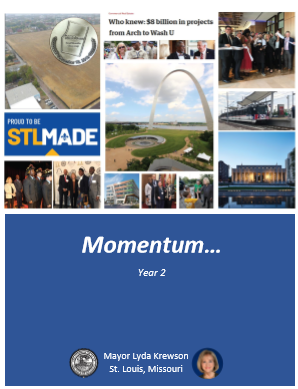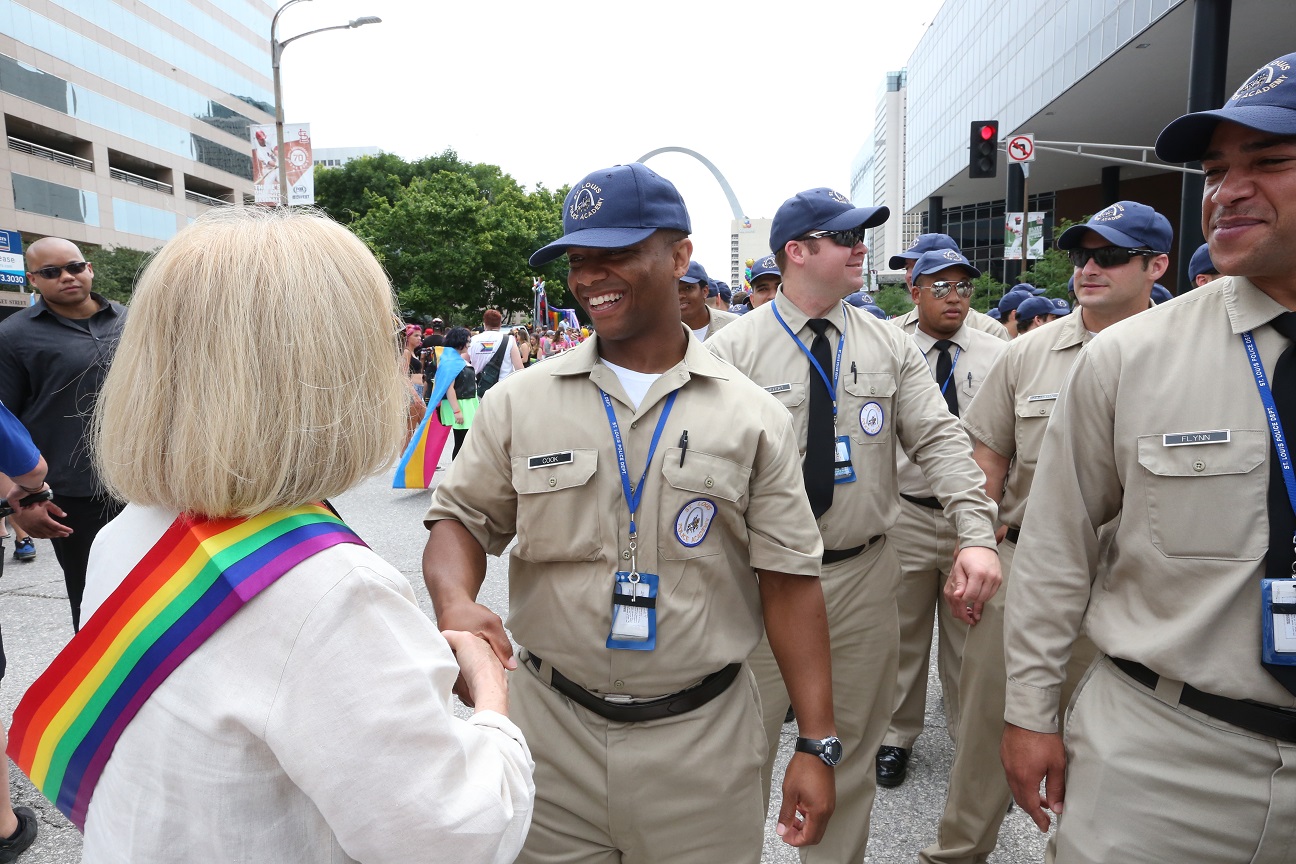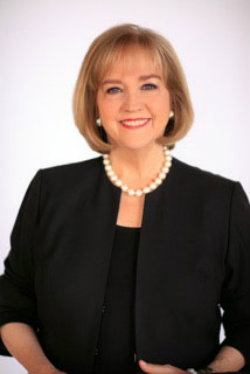 I’m honored to be your mayor at a time of such great momentum!
I’m honored to be your mayor at a time of such great momentum!
As St. Louisans, we are modest. This can be charming, but we have so much momentum to talk about. Each of you have played a part in that momentum, through your companies, your institutions, your professional work, your volunteer work, and your families. You do SO much… government cannot, and should not, do everything! Thank you for your work!
In St. Louis there are over $8 billion in projects recently completed or currently underway. From the Arch, Soldiers Memorial, Ballpark Village, the Enterprise Center, the Aquarium and Ferris wheel at Union Station, SLU and SSM’s new hospital, BJC and Washington University’s campus renewal, the Foundry, the Armory, the Angad Arts Hotel and Hotel St. Louis, Cortex, Chouteau’s Greenway, to new apartment high-rises, and thousands of renovations going on in homes all over the City, including in Old North, the Hill, Fox Park, Tower Grove, Soulard, the Grove, Cherokee, the Ville, Fountain Park, Downtown, Dogtown, Dutchtown, and DeBaliviere.
In 2018, we issued over $1.22 billion in building permits, which represents nearly 4,000 new jobs, more than 6,000 residential units, 2.2 million square-feet in new commercial space, and more than 2,000 new hotel rooms.
There are cranes in the sky and construction dumpsters on the curbs. We are safer, more walkable, cleaner, and more livable. The New York Times recently headlined us, “once-quiet, now-vibrant.” Forbes said of St. Louis, “rebounding,” and named us #2 in “Top Ten Rising Cities for Startups,” and touts a cost of doing business at 8% below the national average. Inc. Magazine said, “Forget Silicon Valley. The most exciting innovations happening in agtech are in this Midwestern city” — and dubbed us the “Turnaround City.”
On December 13th, we turned over the 97-acre National Geospatial-Intelligence Agency (NGA) site to the federal government. Design has begun and the construction contract has been awarded — solidifying this $1.7 billion project, and its 3,100 permanent and 1,500 construction jobs. But the NGA project is more than a new federal facility. It is the opportunity to transform the neighborhoods around the site with businesses, housing development, and opportunities for residents.
Geospatial technology is everywhere, in our computers, our cell phones and many other gadgets. It is an industry projected to reach over $439 billion in market share in 2020, and we expect to continue to grow this sector in St. Louis. We have world-class cultural institutions, and at T-Rex, Cortex and through Arch Grants, we are home to exciting and innovative startups and their creative owners and employees.
Since 2000, we have had a 13% increase in 25-34-year-olds moving into our City. It’s not just about people moving here though, St. Louis continues to be a great place for the families who have lived here for generations.
On March 14th — 314 day — “STL Made” was launched. This is a mostly private sector effort to promote the best of St Louis – the stories of our people, our communities, our attractions, and our momentum. The STL Made campaign reminds those of us who live here, and those around the country, that St. Louis is a place where you can “Start Up, Stand Out and Stay.”
We are supporting the pitch to be named the next Major League Soccer city and working with partners to build a privately-financed soccer stadium. Square is expanding to accommodate 300 new jobs over the next five years, and as Square co-founder and hometown entrepreneur Jim McKelvey said, “there is talent all over the country, not just on the coasts.”
We are continuing an intense focus on economic development, neighborhood safety, vacant properties, advancing as a Smart City, and on improved and equitable service delivery. We have made progress in all of these areas! Thanks to each of you, to the entrepreneurs, the makers, the doers, and the City employees who work hard every day to make it happen.
I am optimistic about our future. Brag on St. Louis every chance you get. Don’t be humble; we have a lot to be proud of. Let’s stick our necks out, keep our sights high, and accomplish even more.
Following are a few of this year’s highlights and a look to Year 3.
Thank you for your involvement and for the opportunity to serve this wonderful and unique place that we call home.
Economic Development
St. Louis continues to see strong momentum, particularly when it comes to economic development. In 2018, the City issued a record breaking $1.22 billion in building permits — $500 million more than the previous year. That number includes projects big and small, from 36-story apartment towers, new hospitals and college buildings, to countless small-scale rehabs and renovations.
Highlights from the past year include:
- National Geospatial Intelligence Agency — Last December, community leaders and local, state, and federal officials celebrated the transfer of 97 acres to the federal government for the Next NGA West site. McCarthy-HITT has been awarded the design/build contract, solidifying this $1.7 billion project. The Next NGA West campus will create 1,500 construction jobs and retain more than 3,100 permanent jobs. The NGA project represents a historic moment for our region – and will chart the course for expansion in emerging technology businesses and jobs.
- Gateway Arch Park and Museum — On July 3rd, the $380 million renovation of the Arch grounds and museum opened to the public. This project represents the largest private investment in any national park ever. Nearly 100 acres of park land were improved. These improvements provide a long-awaited connection to downtown. The underground museum has been expanded to include six galleries, a café, and a new live stream of the view from the Arch viewable from the tram lobby.
-
Soldiers Memorial — Following a 3-year, $30 million renovation, Soldiers Memorial opened to the public in time for Veteran’s Day last November. The renovation includes doubling the exhibit space, the restoration of the many artifacts, and a redesign of Chestnut Street to allow for an extended Court of Honor — the City’s WWII memorial. This beautiful renovation honoring our veterans was made possible by the support of private donors.
These investments in our cultural institutions and landmarks are essential to driving tourism and economic development in our region. Soldiers Memorial and the Gateway Arch are key visitor attractions to our downtown. Making downtown a better place to live, work, and play attracts tourism dollars and helps businesses retain and attract talent to our region.
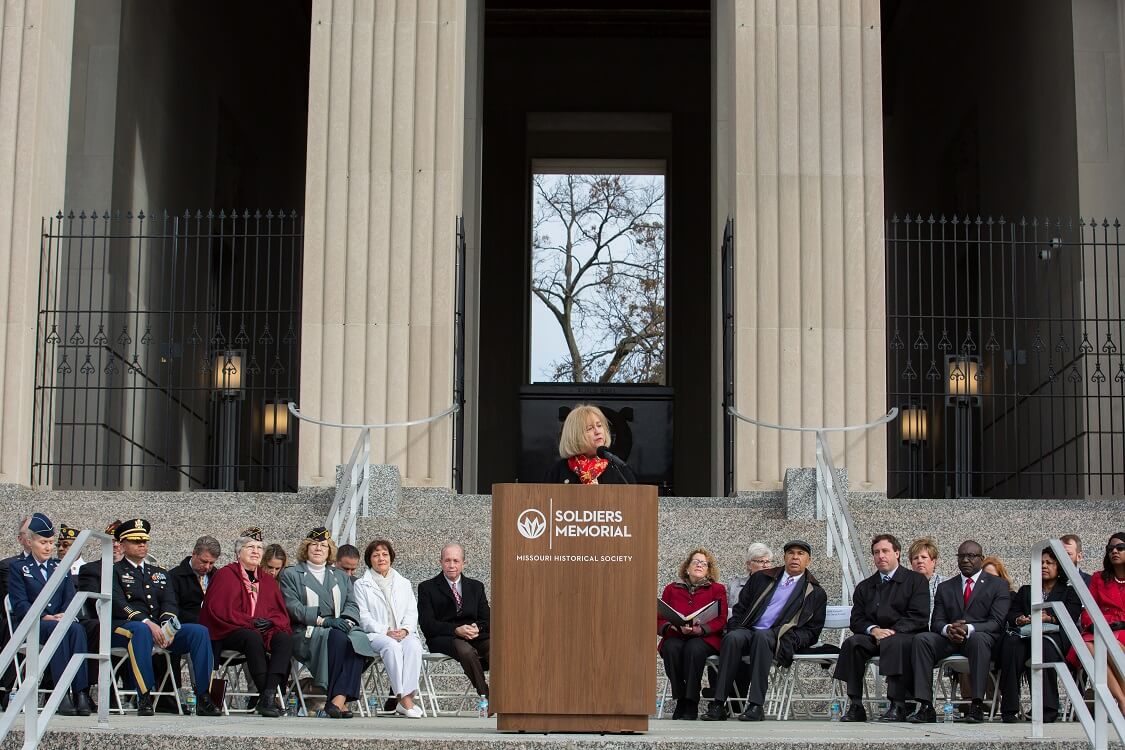
Mayor Krewson welcomed attendees at the Grand Re-Opening of Soldier's Memorial. Photo Credit: JJ Lane, Be Lovel Photography - Cortex Expansion & MetroLink Station — Cortex is the premier innovation hub of bioscience and technology research, development and commercialization, and serves as the anchor of St. Louis’s growing ecosystem for innovative startup programs and established companies. 6,000 employees call Cortex home. In the past year, the new 4220 Duncan building opened in Cortex and is now home to Microsoft’s regional headquarters, the third CIC St. Louis, BJC’s WellAware Center, EdHub STL, The Chocolate Pig, and more. Cortex also saw the opening of the 38th MetroLink Station this past July – the first Metro station to be built in more than a decade.
- Citywide Economic Development Strategy — The St. Louis Development Corporation (SLDC) engaged Mass Economics consulting firm to provide an in-depth analysis of the City’s economy and a comprehensive economic development strategy. The purpose of the strategy is to position the City on the path toward a resilient economy by casting a vision that the City and its partners can coalesce around and act upon to drive investment and growth in the city.
- Holding Northside Regeneration Accountable –paving the way for future development— The City terminated the redevelopment rights of Northside Regeneration, LLC, a private development company led by Paul McKee, which owns nearly 1,700 parcels of land. In 2009, the City approved a development plan for the Northside Regeneration area and granted Northside development rights over the area and also approved up to $390 million in public tax increment financing. The City originally approved the plan and the redevelopment agreement with Northside Regeneration for the promise of much needed redevelopment on the north side. After several years of failed efforts to catalyze development and defaults under the redevelopment agreement, the City served notice to Northside of its defaults and terminated the Redevelopment Agreement. Terminating Northside’s redevelopment rights provides an opportunity to attract new investment to the area.
- Exploring a New Way of Doing Business at our Airport — We are exploring whether a private operator can develop the St. Louis-Lambert International Airport into a stronger economic development asset for our region. We need more flights to more places for both people and freight. Our largest runway is only utilized 10 to 15% of the time, and there are 1,000 acres of developable land at the airport. After a lengthy selection process, the Board of Estimate and Apportionment approved Fly314’s proposal to study the question and consider obtaining proposals to lease the operation of St. Louis-Lambert International Airport. We will not sell the airport! We hope to receive lease proposals to consider before the end of 2019.
Neighborhood Safety is Job #1
Public safety remains our top priority. Police Chief John Hayden, Public Safety Director Judge Jimmie Edwards, and our St. Louis Metropolitan Police Department (SLMPD) have made significant progress in reducing violent crime. While violent crime decreased 15%, and overall crime decreased 6% in 2018, one crime is one too many. Violent crime takes a big toll on our families, businesses and our entire region.
- Hayden’s Rectangle — One of Chief John Hayden’s priority initiatives, the Hayden Rectangle, identified the highest crime area — Goodfellow to Vandeventer, Dr. Martin Luther King to West Florissant — and focuses additional manpower from special units in the area. Better Family Life (BFL) focused on deescalation, and the Regional Businesses Council and BFL hosted five weekend “Clean Sweep” events to remove derelict buildings and clean up alleys and lots. The result was an 18% decrease in crime in Hayden’s Rectangle, including a 24% decrease in homicides, a 23% drop in robberies, and a 15% decrease in aggravated assaults with a firearm. The SLMPD is in the process of expanding this strategy to two additional areas — Downtown and the Gravois Park/Dutchtown area.
The Police Department continues to lead the regional Carjacking Task Force to reduce and prevent carjackings in the region. The Carjacking Task Force is a collaboration between the SLMPD, St. Louis County Police, the FBI, the ATF and the Missouri and Illinois Highway Patrols. - Officer Recruitment — Like many cities, St. Louis struggles to recruit new police officers. We are between 120 to 140 officers below our authorized force on any given day. This year, two new professional police recruiters will join our team. We know that the residency requirement in the City’s Charter limits our ability to attract some candidates. Therefore, we have waived this requirement for at least 50 new officers in an effort to expand the applicants. If you know someone interested, contact the SLMPD Department of Personnel at 314-444-5615 or apply at slmpd.org/careers.
- Cadet Program — Last summer, SLMPD kicked off a new Cadet Program to offer young people, ages 18 to 24, the opportunity to explore a career in law enforcement, while also attending college. Cadets work 15 hours a week, and earn $13 to $15 per hour as they receive training and mentoring. We believe this provides valuable experience and allows interested high school graduates to stay on a path toward becoming an officer before entering the Police Academy at 21. Apply to join the Cadet Program at slmpd.org/cadet_program
Mayor Krewson meets cadets working at the 2018 Pride Parade. Photo Credit: Bill Greenblatt - Municipal Court Amnesty Continues — Over the past two years, the City has held three amnesty programs for the Municipal Courts. In March, the Municipal Courts hosted a warrant amnesty program which allowed people with outstanding warrants for traffic violations and other minor municipal charges to set up payment plans to resolve outstanding debts and/or reschedule new court dates. As a part of the three-day program in March, more than 6,945 warrants were cleared for 1,601 individual defendants.
- Reducing the Jail Population — Reducing our jail population, while at the same time protecting public safety, is an important priority. Through the combined efforts of my office, Public Safety Director Judge Jimmie Edwards, Circuit Court judges, prosecutors, corrections staff, SLMPD, and the State’s Division of Probation and Parole, the daily jail population has been reduced from 1,400 in 2016 to 1,100 currently. It is important to note that 99% of the detainees are being held on felony charges.
In October, with the financial help of private partners, two executives from the FUSE Corps joined our team for 1 year. FUSE is a national nonprofit that partners with local governments to provide assistance with specific initiatives. Debbie Allen is leading our effort to establish the Criminal Justice Coordinating Council. The Council is made up of elected and criminal justice leaders who meet regularly to coordinate services with the goal of improving outcomes. Wil Pinkney is leading our effort to reform and develop alternatives to cash bail. Confinement of pretrial detainees is needed for individuals who are a threat to the public, to themselves, or who are a flight risk. - MacArthur Grant — The City won a $50,000 Safety and Justice Challenge grant from the MacArthur Foundation, which includes a collaboration with Stanford University to establish data, and data analytics for our criminal justice system. Better data is necessary to provide the information needed for making the best decisions possible.
Vacant Buildings and Lots
There are roughly 25,000 vacant parcels in the City — 17,000 are vacant lots and 8,000 are vacant buildings. About half of these properties are privately owned, and about half are owned by Land Reutilization Authority (LRA). In partnership with many private and non-profit agencies, we have significantly increased our efforts to reduce the number of vacant buildings. Nothing good happens in a vacant building!
- Vacancy Plan Released — In July, we released a comprehensive plan on how the City and partners in the private sector will reduce vacant buildings and lots. This plan includes new ways of tracking and monitoring vacancy, strategies to sell more LRA owned vacant properties, and new efforts to demolish buildings that can’t be saved. None of the work in this plan would be possible without the support of so many community partners that have stepped up to address this issue.
- Selling Buildings That Can Be Renovated — Beautiful historic architecture is the soul of our built environment. Our goal is to preserve St. Louis’s architecture and save as many properties as possible. Many buildings that are vacant today could be returned to productive use — becoming homes for families and businesses. A number of the programs the City has advanced this year are working to do just that.
- Dollar Housing Pilot Program —The Dollar Housing Pilot Program is a new initiative where residents can buy LRA owned houses in need of a little (or a lot of) elbow grease. Buy one of these homes for $1, bring the property up to code in 18 months, live in the home for at least 3 years… and it is yours. Last month, we sold the first six $1 homes. There are almost 500 available. Find yours here.
- Demolishing Buildings That Are Beyond Saving — Unfortunately, some buildings are just too far gone to renovate. These vacant and abandoned buildings pose a significant public safety threat to neighbors and businesses. In 2018, 327 vacant buildings were demolished, compared to 149 in 2017. We also increased funding for demolitions to $3.6 million, an increase of $2 million over the previous fiscal year. In the coming year, we propose to budget even more funding for demolition, and we hope to demolish as many as 500 dangerous, vacant buildings. We are also partnering with private groups who are providing resources towards this effort.
- Clean Sweep — This past summer, we partnered with the Regional Business Council, Better Family Life, KWAME Building Group, private contractors, and hundreds of volunteers to demolish vacant buildings and clean up lots, as part of the Clean Sweep initiative. Construction crews from Fred Weber, Keeley Companies, McCarthy Construction, BSI, Clayco, Straughter Company, Ben Hur Construction, Holland Construction Company, PARIC, and S.M. Wilson donated thousands of hours and equipment. Because of their generosity, were able to take down roughly 30 vacant buildings and clear hundreds of lots in the Hamilton Heights, Wells-Goodfellow, Jeff Vander Lou, Penrose, and Walnut Park neighborhoods. • Deconstruction Pilot Program — Deconstruction is a sustainable building demolition process that uses hand tools to carefully disassemble structures in order to salvage and recycle bricks, wood and metals. We are launching a pilot program to develop capacity and increase the number of vacant properties deconstructed. The pilot project – which includes 30 buildings – will also provide training for contractors and City residents.
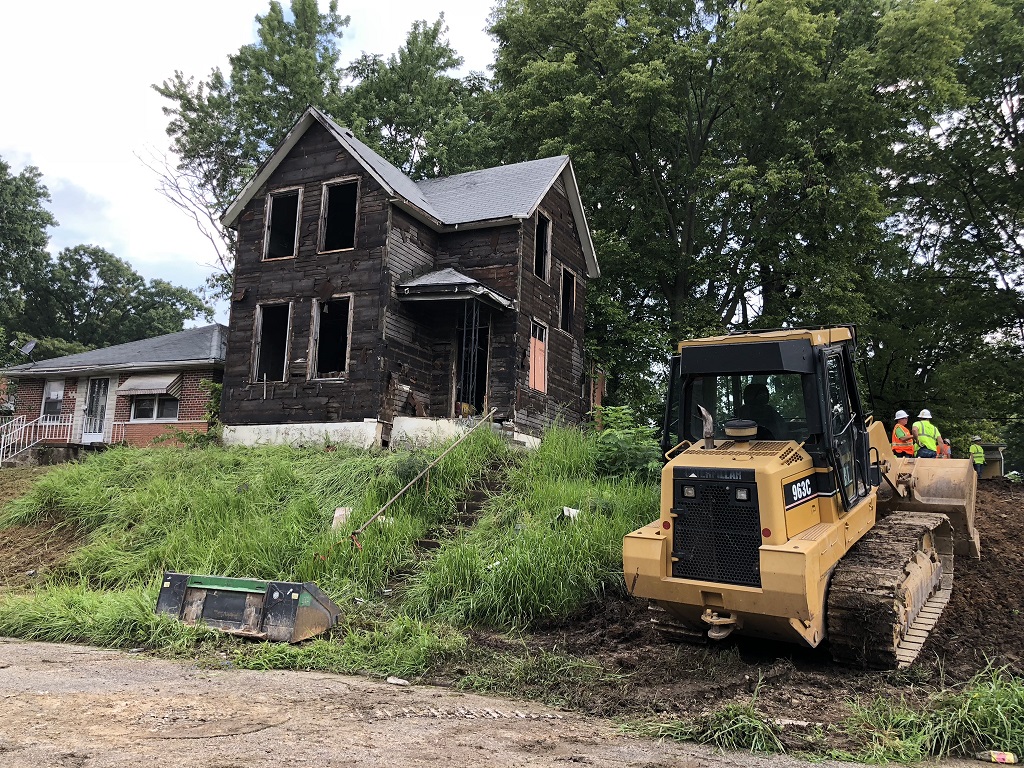
Crews donated their time and equipment to take down vacant houses, including this house in the 27th Ward. - Targeting Privately-Owned Vacant Buildings — About half of our vacant properties are privately owned. This represents a significant challenge. Some owners have literally walked away from their properties, some owners are very difficult to locate, and still others are hundreds and thousands of miles away. Our citations and notices for code violations are often ignored. We continue to try to find them and hold them accountable. The Neighborhood Vacancy Initiative, created last year, is a collaboration between Legal Services of Eastern Missouri, St. Louis Development Corporation (SLDC), and the Bar Association of Metropolitan St. Louis (BAMSL). The Initiative provides legal services to neighborhood groups and nonprofits in order to address issues related to problem properties with private owners.
- Mow to Own Program — The Mow to Own program allows City residents to mow the lot next door and own it after two years. This program is increasingly popular. Last year, we expanded the program to allow commercial owners as well as residential property owners to “mow-to-own.” We also increased the size of eligible lots from 30 feet to 40 frontage feet. Since its inception, 265 property owners have participated in the program.
A Better St. Louis for All
We remain committed to advancing policies and programs that make St. Louis more equitable and that improve outcomes for all of our residents.
- Health Director - Dr. Fred Echols — In February, we welcomed Dr. Fred Echols as the new director of the City’s Department of Health. Dr. Echols is the first medical doctor to serve in this position since 2007. Prior to joining our team, Dr. Echols served the St. Louis County Health Department as the director of Communicable Disease, Vector and Veterinary Programs. I’m excited to have him on board.
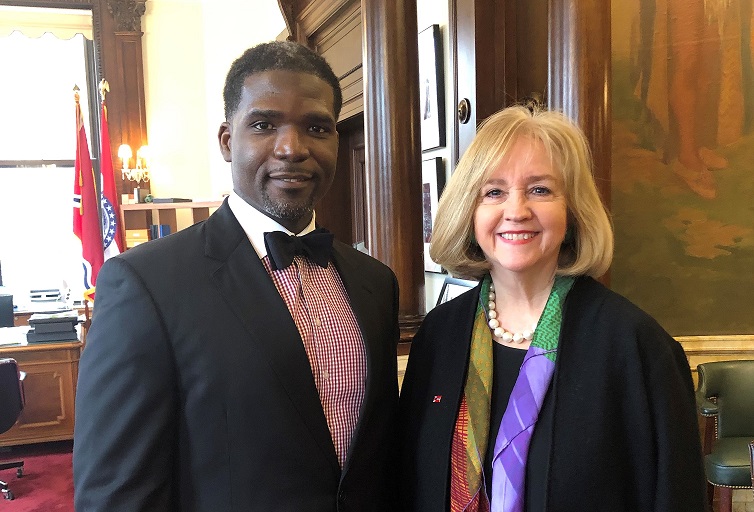
Mayor Krewson welcomed Dr. Echols as the new director of the City's Health Department in February. - $5.3 Million in Grants & Loans Given by Affordable Housing Trust Fund — As our city experiences increased economic momentum, we know that St. Louis remains affordable. In the 2019 fiscal year budget, we dedicated $5.3 million to the City’s Affordable Housing Trust Fund, the highest allocation to this fund in over a decade. This winter, the Affordable Housing Commission issued $5.2 million in grants and loans, which will be used to support more than $100 million in programs and services to low- and moderate-income St. Louisans. Affordable Housing Trust Fund dollars will help to create 131 new rental units and 34 for-sale homes for families this year alone. Of this total, 22 homes will be directly subsidized for low- and moderate-income families. These funds will also support services for those currently experiencing homelessness and programs to prevent homelessness.
- STL Youth Jobs — STL Youth Jobs employed 739 young folks last summer. We expect to employ 1,000 this summer. We know that a summer job can have a transformative effect on any young person, but especially those living in some of our most challenged communities. The City’s investment has increased from $300,000 in 2017 to $475,000 in 2018; and we expect to put $775,000 into the program this year. Private partners contribute over $1.5 million to the program. Young people ages 16 to 24 can apply for a job this summer at www.stlyouthjobs.org .
- Released the Equity Indicators Report —This past year the City released the baseline Equity Indicators report, which was a recommendation of the Ferguson Commission. The report looks at where we stand on racial equity across 72 different indicators. As the report makes clear, we have a lot of hard work to do in several areas, especially education and issues affecting youth. This report will allow the City and stakeholders to track progress in addressing these inequities.
- Strategy for Resilience — Soon, we will release the City’s Resilience Strategy, a plan to make the City and its residents more resilient to the challenges we face from natural disasters, flooding, population decline, poverty, and other social challenges. The strategy was a result of a three-year partnership with 100 Resilient Cities and the Rockefeller Foundation It was put together with the help of hundreds of local stakeholders. The 33 actions outlined in the strategy will be carried out over the coming months and years and have the power to benefit St. Louisans for decades to come.
- Serving the Unhoused and Preventing Homelessness — Preventing and addressing homelessness is a 365 day a year job — not just when it receives a lot of attention on the coldest days. All year long, we work closely with the Continuum of Care, the volunteers of St. Louis Winter Outreach, nonprofits, community and faith organizations and various City departments to respond to the needs of our community members who are experiencing, or are at risk of experiencing, homelessness.
Thank you to all of our partners, especially this year, as they stepped up to assist unhoused St. Louisans during a particularly cold and wet winter. - Welcoming Homefull at Biddle House — In October, the City welcomed Homefull as the new operator of Biddle Housing Opportunities Center. Homefull has proven experience operating emergency shelters and helping folks obtain permanent housing. We’re excited to have them as partners.
- Rallying Region to Address Veteran Homelessness — As Michelle Obama has said, no one who has worn this country's uniform should ever have to spend a single night — even a single hour — out on the streets. We have joined the St. Louis Area Regional Commission on Homelessness challenge to bring an end to veteran homelessness in the St. Louis region. Partners in this effort have adopted the Built for Zero model that relies on real-time data to identify and assist veterans with resources and permanent housing.
Efficient and Reliable Service Delivery
Efficient and reliable services delivery for every resident and business is essential. Budget challenges are a continual issue and require tough choices.
- $50 Million Bond Issue - Passed August 2018 — In August, voters passed Proposition 1, a $50 million no-tax increase bond issue that allows the City to invest in much needed equipment and upgrade aging infrastructure. With these dollars, the City will buy new fire trucks, upgrade our outdated payroll and finance systems, and make improvements to buildings. These funds will also help us evaluate our public buildings, sidewalks, bridges and intersections for compliance with the Americans with Disabilities Act. Learn more about Prop 1 and why it’s needed here.
- New Trash Trucks — After more than a decade of almost no investment in equipment, we were finally able to purchase 22 new trash trucks this year. Before buying the new trucks, the average age of our trash trucks was 20 years old! Because of the new refuse trucks, residents and businesses can now rely on their regular trash, recycling, yard waste, and bulk pick-up.
- Equitable Infrastructure Growth Program — Last year, we launched the Equitable Infrastructure Growth Program as part of the federal “Smart City” initiative, which uses technology to modernize the way cities tackle everyday problems and improve quality of life for residents. Under the EIG program, the City will take a proactive approach to • Modernize and expand the City’s infrastructure • Provide equal access to fast and affordable internet service • Use smart technologies to prevent power outages, reduce the time it takes to detect them, and increase the speed at which service is restored after an outage.
- Smart Kiosks — This summer “smart kiosks” will be installed in public places beginning in downtown and at Metro stops. The smart kiosks will provide free public Wi-Fi, information on points of interest, events, transportation options, and community attractions. The kiosks also have built-in public safety features including panic functions and the ability to broadcast emergency alerts.
Looking Ahead
- Prop NS — In 2017, voters approved Proposition NS, a measure that establishes a $40 million fund to stabilize vacant LRA-owned buildings. After a protracted legal battle, and with help from the St. Louis Association of Community Organizations (SLACO) and the Board of Aldermen, Prop NS is launching! Prop NS will fund up to $30,000 per home to be used to stop the decline of buildings that are still in decent condition and which are good candidates for renovation and occupancy. We expect the funds will be used to board up buildings, make them watertight, tuckpointing, and fixing roofs and gutters. Buildings which have these major repairs completed will be attractive to buyers interested in renovation and rebuilding our historic brick neighborhoods.
- MLS for the Lou — A new bid to attract major League Soccer to St. Louis was launched with what could be the first majority femaleowned Major League Soccer team. Led by the Taylor and Kavanaugh families, this proposal differs from the 2016 bid in that the team will be 100% St. Louis owned and would be almost entirely privately funded. The new stadium would be located downtown, west of Union Station. The MLS is expected to make their final decision later this year. We believe St. Louis is their best choice. We are optimistic about our chances. Learn more at mls4thelou.com.
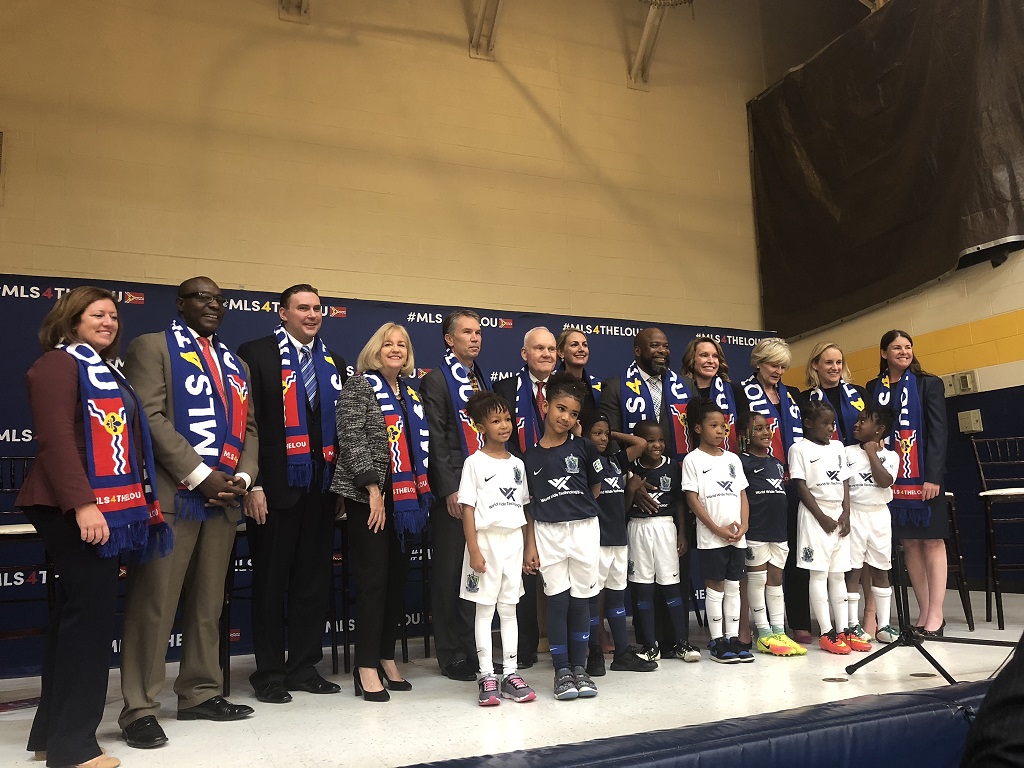
Mayor Krewson joined the MLS4THELOU ownership group, fellow elected officials and youth soccer players from Matthews-Dickey Boys and Girls Club for the kick-off announcement. - America’s Center Convention Center Expansion Project — The City, in partnership with St. Louis County, has agreed to issue new bonds to complete major renovation and expansion of our 42-year-old convention center. The renovation project is critical to attract and retain conventions and other events which bring 5.8 million visitors to St. Louis, support 88,000 jobs, and create $5.8 billion in direct spending to our economy. In order to remain competitive, the renovation, called the AC Next Gen Project, will add 92,000 square feet of new exhibit space, a 65,000 square feet multi-purpose ballroom, an overhaul of the central Washington Avenue entrance, and more. The $175 million plan will be paid for by utilizing the existing hotel tax. See the video here.
- Bloomberg American Cities Climate Challenge — Last October, Bloomberg Philanthropies named St. Louis a winner of the Bloomberg American Cities Climate Challenge. As a winning city, St. Louis joins a two-year program where Bloomberg Philanthropies will provide in-person technical assistance and support to help St. Louis improve energy efficiency in public and private buildings, develop and execute a comprehensive solar action strategy, and accelerate the availability of electric vehicle infrastructure and use of electric vehicles.
- Chouteau Greenway — The City continues to be an active partner in the planning of the Chouteau Greenway. The Chouteau Greenway will transform St. Louis by connecting people and our City’s most treasured places, creating inspiring experiences and equitable opportunities for growth. More than just a free, accessible trail where people can exercise, commute or explore, the project’s goals include offering an exceptional experience to residents and tourists alike. The greenway aims to create dynamic, active spaces and serve as a regional gathering place that encourages collaboration and boosts civic pride. It is a network of accessible trails and greenways connecting the Arch to Forest Park, and Tower Grove Park to Fairground Park — traversing through 19 city neighborhoods.
- City-County Combination — Most of us know that the fragmented government in our region does not work well for many residents. We know our communities have starkly different outcomes in life expectancy, educational attainment, and job opportunities.
We fuss over where the next big development will go, we argue about who should pay for upgrades at our convention center, and we don’t make our big decisions with the best interests of the whole region in mind. We spend a lot of effort competing against one another, rather than competing against other big cities for business, jobs, and growth. Across the region, we currently have:
• 55 police departments
• 88 municipalities
• 78 municipal courts
• 650 elected officials
In January, a task force unveiled a proposal that would take the “Old City” and the “Old County” and combine them into one new Metro City, with 1.3 million people. That would make St. Louis the 9th or 10th largest city in the country, while also preserving the identities and character of the municipalities. This restructuring will save significant money in future years which could be used for other needs. Standardized high-quality law enforcement training, without the need to generate funds from citations, will improve life for many people who have spent years shuffling in and out of the many municipal courts for very minor violations because of their inability to pay fines. Addressing social, educational, health, homeless, and safety needs as a region is needed. St. Louis also will no longer lead the national crime rankings, making us more attractive to businesses and making it easier to attract and retain talent.
No doubt, the restructuring proposed is difficult! Change is hard! During this next year, we will have the opportunity to study, discuss, and consider if we want to come together as a region. I look forward to our discussions.
We have so much great momentum… Thank you for the privilege of serving as your Mayor.
